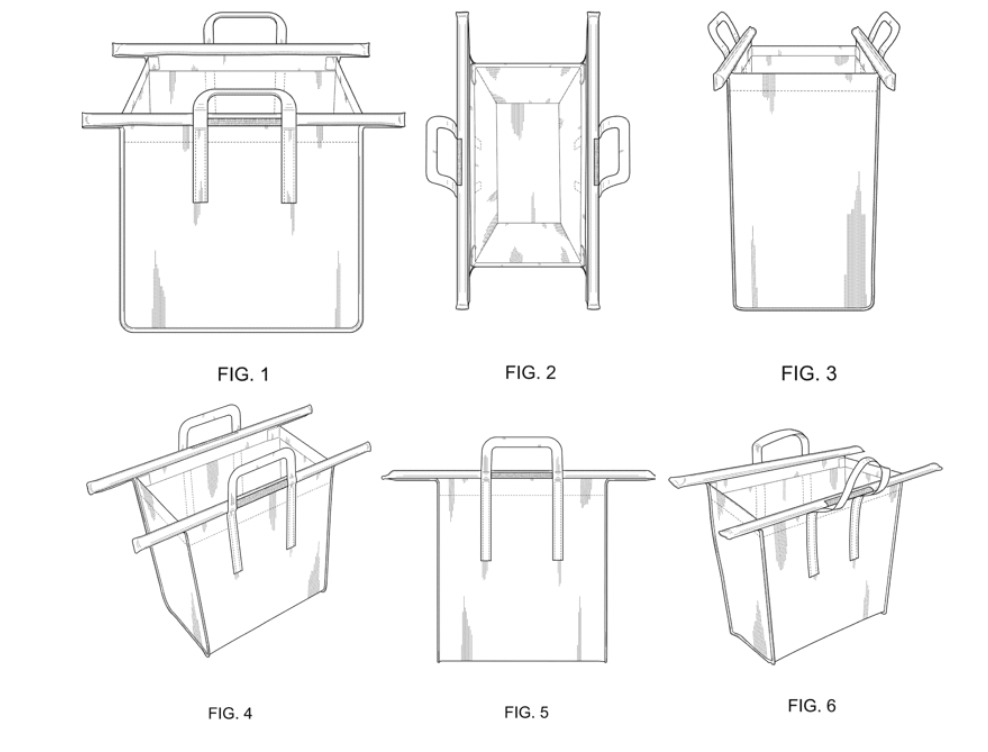“[T]he district court did not commit clear and obvious error when it held that the design of the ‘828 patent was functional. The horizontal poles of the claimed design were required for the purpose of standing the bag upright in a cart.”
 On June 22, the U.S. Court of Appeals for the Federal Circuit (CAFC) affirmed a decision by the United States District Court for the Southern District of California granting summary judgment in favor of Golden Eye Media USA Inc (GEM) over Evo Lifestyle Products Limited, formerly known as Trolley Bags UK Ltd (TB UK) after holding TB UK’s U.S. Design Patent No. D779,828 (‘828 patent) invalid. The district court held the ‘828 patent to be invalid for reasons of functionality and obviousness.
On June 22, the U.S. Court of Appeals for the Federal Circuit (CAFC) affirmed a decision by the United States District Court for the Southern District of California granting summary judgment in favor of Golden Eye Media USA Inc (GEM) over Evo Lifestyle Products Limited, formerly known as Trolley Bags UK Ltd (TB UK) after holding TB UK’s U.S. Design Patent No. D779,828 (‘828 patent) invalid. The district court held the ‘828 patent to be invalid for reasons of functionality and obviousness.
‘828 Design Patent and Procedural History
The ‘828 patent is directed to “a reusable and foldable shopping bag that fits within a shopping cart” owned by TB UK. TB UK additionally claims a common law trademark for “TROLLEY BAGS” which can be found on the reusable shopping bags that TB UK sells. GEM also sells reusable shopping cart bags that have the mark “LOTUS TROLLEY BAGS” on them.
In July 2017, TB UK asserted that GEM’s sales of their reusable shopping cart bags infringed both TB UK’s ‘828 patent and their common law trademark in a cease-and-desist letter that they sent to GEM. In September 2018, GEM sought a declaratory judgment against TB UK in the district court. GEM asked that the court find that GEM did not infringe the ‘828 patent, the ‘828 patent was invalid for obviousness in view of Irish Patent Pub. 2009/0718 (Doyle) and U.S. Patent No. 5,046,860 (Brennan) and functionality, and GEM did not infringe the common law trademark owned by TB UK. Both parties moved for summary judgment, with the court granting GEM’s motion holding the ‘828 patent invalid and GEM did not infringe TB UK’s trademark.
Functionality
The district court found the ‘828 patent to be invalid because its design was dictated by function. TB UK in response argued the district court erred in its holding because it misapplied the five-factor test relating to functionality laid out in Sport Dimension Inc. v. Coleman Co. (Fed. Cir. 2016). TB UK alleged the district court failed to resolve disputed factors in favor of them, the non-moving party, and applied the wrong legal standard when finding the patented design was “dictated by function” instead of being “dictated solely by function.” In response, GEM argued that the district court correctly applied the Sport Dimension test and applied the correct legal standard when finding the patent to be dictated by function.
The CAFC noted that the district court’s finding would be reviewed for clear error and outlined the five factors that are used in determining whether a design is dictated by function. The court considers whether (1) the best design is the design that is protected, (2) “alternative designs would adversely affect the utility of the specified article,” (3) are there any concomitant utility patents, (4) the advertising for the design touts any particular features as having specific utility, and (5) “there are any elements in the design or an overall appearance clearly not dictated by function.”
The court sided with GEM, finding that the district court did not commit clear and obvious error when it held that the design of the ‘828 patent was functional. The horizontal poles of the claimed design were required for the purpose of standing the bag upright in a cart. The alternative designs would have a direct and adverse impact on the functionality of the bag system. This finding weighed in favor of finding the patent invalid based on the first, second, and fifth factors of the Sports Dimension test. Regarding the third factor, the district court found that Doyle, which was owned by TB UK, was not classified as a utility patent in Ireland, and Brennan was not owned by TB UK. These findings did not weigh in favor or against the invalidity of the ‘828 patent. The district court noted that the advertisements by TB UK touted the utility of the bag, which weighed in favor of a finding of invalidity.
The CAFC found that these holdings were not clearly erroneous and therefore affirmed the district court’s finding of invalidity based on functionality. TB UK argued in response that the district court did not consider the alternatives presented, which the court found to be unnecessary. TB UK discussed two possible alternative designs, but the CAFC determined that the district court correctly disposed of the alternatives because TB UK only presented alternative designs in which the bags could be larger or smaller and these alternatives would directly affect utility.
Obviousness
The CAFC also addressed TB UK’s appeal regarding the district court’s finding of invalidity based on obviousness. TB UK argued the district court should have found that the factual issues prevent a finding of summary judgment and the decision by the district court to use Doyle as a primary reference. TB UK noted in their argument that the United States Patent and Trademark Office (USPTO) had already determined that Doyle was not invalidating prior art during their reexamination and Doyle was too different from the design of the ‘828 patent to be used as a primary reference. TB UK asserted the USPTO’s conclusion undermines the court’s conclusion that no genuine issue of material fact existed.
GEM responded, arguing the district court correctly determined that Doyle was a primary reference and Brennan was a secondary reference that could be combined with Doyle to create the same overall visual appearance of the ‘828 patent. In design patents, a determination of obviousness requires a two-step inquiry to determine if a designer of ordinary skill in the art would have combined the prior art to create a similar visual appearance. The first step is to identify a single reference with basically the same design characteristics as the claimed design. This requires the court to look at the “visual impression created by the patented design as a whole.” In the second step, other references can be used to modify the primary reference to create the same overall visual appearance of the claimed design.
The CAFC agreed with GEM the ‘828 patent was correctly found to be obvious. The court found that the district court’s use of Doyle was consistent with its precedent. In finding that Brennan was the correct secondary reference, the court noted:
“Brennan contains similar handle stitching to the ’828 patent, and these handles combined with the bag shape and handles of Doyle would create a shopping cart bag that highly resembles the one claimed by the ’828 patent.”
Trademark Infringement
The court concluded its analysis by finding the district court correctly determined that GEM did not infringe the common law trademark owned by TB UK. TB UK argued the district court improperly analyzed the underlying evidence when determining the likelihood of confusion. GEM responded by noting that TB UK did not provide any evidence showing a likelihood of confusion. The CAFC applied the law of the Ninth Circuit, which uses an eight factor from AMF Inc. v. Sleekcraft Boats (9th Cir. 1985) when evaluating trademark infringement claims. The court held that the district court correctly analyzed the Sleekcraft factors. The district court first noted the two logos are markedly different since the words “TROLLEY BAG” are different sizes, colors, and in different locations. The district court held that aside from the goods weighing in favor of a finding of infringement, all the other factors weighed in the opposite direction and TB UK provided no proof of actual confusion.

![[IPWatchdog Logo]](https://ipwatchdog.com/wp-content/themes/IPWatchdog%20-%202023/assets/images/temp/logo-small@2x.png)

![[Advertisement]](https://ipwatchdog.com/wp-content/uploads/2024/04/Patent-Litigation-Masters-2024-sidebar-early-bird-ends-Apr-21-last-chance-700x500-1.jpg)

![[Advertisement]](https://ipwatchdog.com/wp-content/uploads/2021/12/WEBINAR-336-x-280-px.png)
![[Advertisement]](https://ipwatchdog.com/wp-content/uploads/2021/12/2021-Patent-Practice-on-Demand-recorded-Feb-2021-336-x-280.jpg)
![[Advertisement]](https://ipwatchdog.com/wp-content/uploads/2021/12/Ad-4-The-Invent-Patent-System™.png)







Join the Discussion
No comments yet.